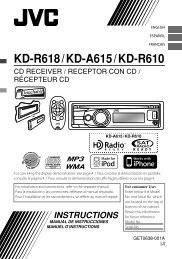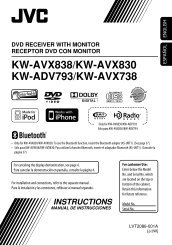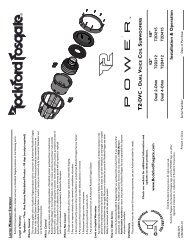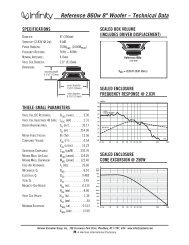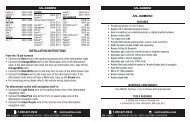Instructions for use of Weight Watchers bathroom ... - Scales by Conair
Instructions for use of Weight Watchers bathroom ... - Scales by Conair
Instructions for use of Weight Watchers bathroom ... - Scales by Conair
You also want an ePaper? Increase the reach of your titles
YUMPU automatically turns print PDFs into web optimized ePapers that Google loves.
<strong>Weight</strong> and Body Fat<br />
How does it work?<br />
While body fat can be measured in many ways, the method <strong>use</strong>d in your scale<br />
is bioelectrical impedance. This indirect method <strong>of</strong> determining body fat starts when<br />
a safe and very low electrical current is sent through the lower half <strong>of</strong> the body.<br />
The electrical current flows more quickly through water and muscle than it will<br />
through bone and fat. The scale measures the speed <strong>of</strong> the current. Based on this<br />
number, the scale estimates body fat using a multi-step, mathematical <strong>for</strong>mula.<br />
Is it accurate?<br />
Measurements <strong>of</strong> body fat tend to fluctuate a lot more than simple weighing,<br />
and different methods <strong>of</strong> estimating body fat yield very different results. Just as<br />
different scales give different results, different body fat analyzers can provide<br />
very different body fat estimates. Even with the same scale the numbers will<br />
vary beca<strong>use</strong>:<br />
• <strong>Weight</strong> loss tends to produce substantial, continuous, and unpredictable changes<br />
in body water content. Beca<strong>use</strong> body fat analysis is determined <strong>by</strong> water content<br />
in the body, results can vary considerably from day to day.<br />
• Hydration status affects body fat results. If you’ve just worked out, there is less<br />
water <strong>for</strong> the electrical current to flow through. This may result in a higher body<br />
fat result. In the same way, if you measure your body fat after drinking a lot <strong>of</strong><br />
fluid, it may appear that body fat is lower than it really is.<br />
• Skin temperature can have an influence also. Measuring body fat in warm humid<br />
weather when skin is moist will yield a different result than if skin is cold and dry.<br />
• As with weight, when your goal is to change body composition it is better to track<br />
trends over time than to <strong>use</strong> individual daily results.<br />
• Results may not be accurate <strong>for</strong> persons under the age <strong>of</strong> 16, or persons with<br />
an elevated body temperature, diabetes or other health conditions.<br />
What you need to know!<br />
• Percent body fat refers to the number <strong>of</strong> pounds <strong>of</strong> fat divided <strong>by</strong> your total body<br />
weight and multiplied <strong>by</strong> 100.<br />
• During weight loss, percent body fat doesn’t appear to be reduced as quickly<br />
as expected beca<strong>use</strong> total weight loss and total body fat are decreasing at the<br />
same time (<strong>for</strong> a more detailed explanation, see next section).<br />
• <strong>Weight</strong> loss in the <strong>for</strong>m <strong>of</strong> body fat and lean tissue (muscle) is common, and<br />
is normal.<br />
• To minimize the loss <strong>of</strong> lean tissue, include regular physical activity, especially<br />
strength training, in your weight-loss plan.<br />
Why do I lose weight but my body fat percentage doesn’t change much?<br />
When you lose weight, both the numerator (pounds <strong>of</strong> body fat) and denominator<br />
(total body weight) go down, so when it’s calculated as a body fat percentage, the<br />
number can be small. For example, a person may weigh 200 pounds and have<br />
40% body fat (= 80 pounds <strong>of</strong> body fat). He/She loses 20 pounds, but the body fat<br />
has only dropped 4% to 36%. That 4% <strong>of</strong> body fat was 16 pounds <strong>of</strong> fat – a very<br />
significant amount! So do not be overly concerned if you do not see the percentage<br />
change quickly as you are losing weight: monitor the absolute number <strong>of</strong> body fat<br />
pounds lost. Remember, to minimize the loss <strong>of</strong> lean tissue, include regular physical<br />
activity, especially strength training, in your weight-loss plan.<br />
Body Water/Hydration Levels<br />
General health standards indicate that one should consume approximately<br />
64 oz. <strong>of</strong> water per day from food and liquids to maintain a healthy level <strong>of</strong> hydration.<br />
Maintaining a good hydration level will help improve your overall health and<br />
general feeling <strong>of</strong> well-being. If your hydration levels are lower than average, you<br />
should increase your water intake accordingly.<br />
Body water/hydration level – how is it measured?<br />
The hydration level is measured <strong>by</strong> using Bioelectric Impedance Analysis (BIA).<br />
The same analysis that is <strong>use</strong>d to calculate your body fat is <strong>use</strong>d to calculate your<br />
hydration level. Taking into consideration a <strong>use</strong>r’s age and gender, a calculation is<br />
made that determines the percentage <strong>of</strong> water.<br />
Please note: It is not recommended to take the hydration measurements in<br />
certain situations, such as following exercise, after drinking a glass <strong>of</strong> water, or<br />
directly prior to, during or shortly after menstrual cycles. Hydration may not be at<br />
normal levels during these times.<br />
Bone Mass – What Is It?<br />
Bone is a living, growing tissue. During youth, your body makes new bone tissue<br />
faster than it breaks down older bone. In young adulthood, bone mass is at<br />
its peak; after that, bone loss starts to outpace bone growth, and bone mass<br />
decreases. But it’s a long and very slow process that can be slowed down even<br />
more through calcium-rich diets and weight-bearing exercise.<br />
Who should monitor bone mass?<br />
Most people have no need to monitor bone mass, but certain groups – post-<br />
menopausal women, men and women with certain diseases, and anyone who<br />
takes medications that affect bone tissue – might want to watch <strong>for</strong> decreases in<br />
bone mass. The bone mass reading is to be <strong>use</strong>d as guide only. Watch <strong>for</strong> trends<br />
over time and contact your healthcare provider <strong>for</strong> a more detailed explanation <strong>of</strong><br />
the readings and with any questions or concerns.<br />
Body Analysis Table<br />
Always keep in mind that you know your body best. The following ranges <strong>of</strong><br />
body fat, BMI, body water and bone mass are <strong>of</strong>fered as guides.<br />
low on target high<br />
BMI





